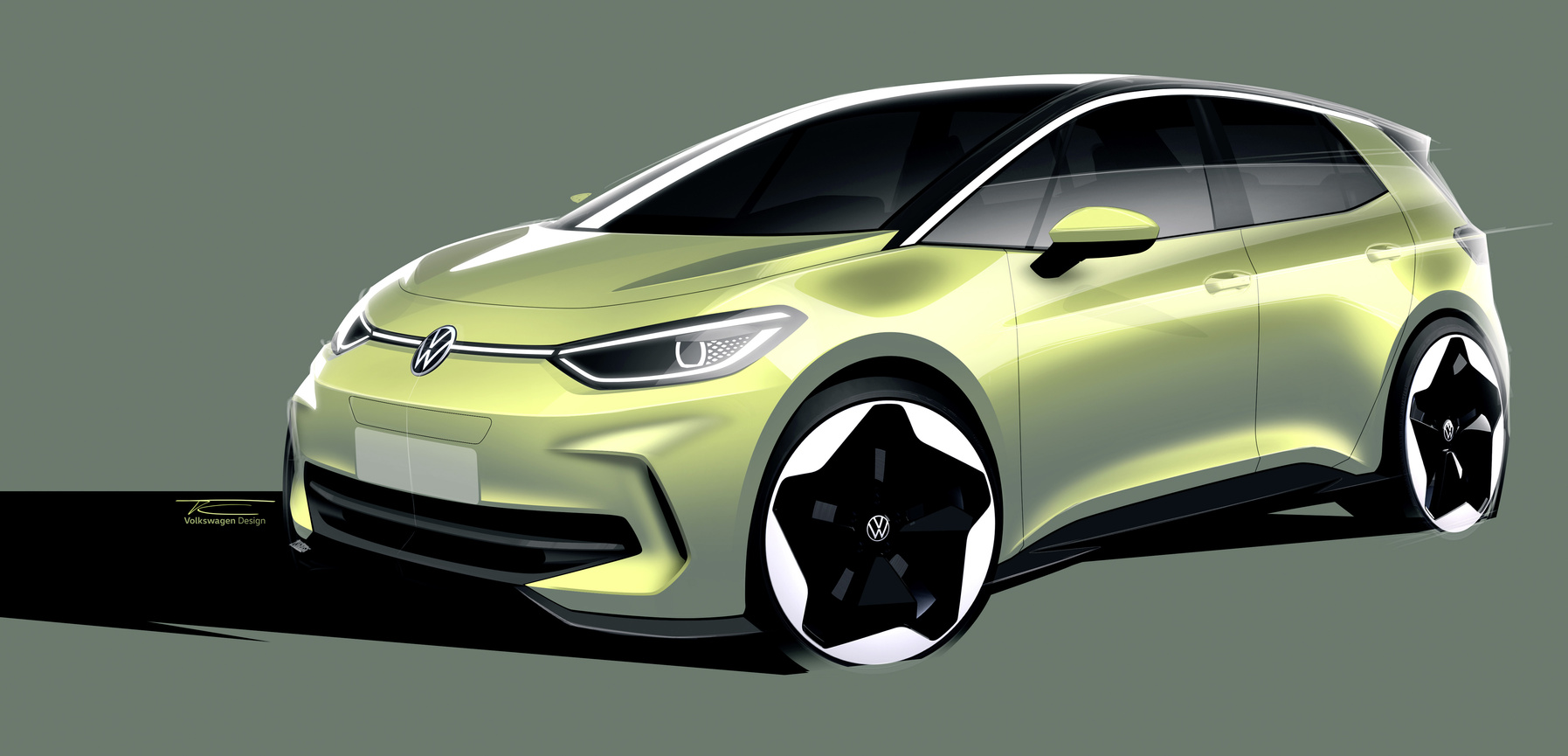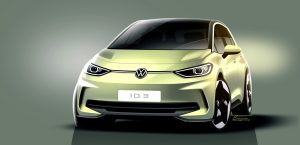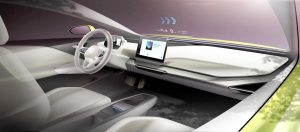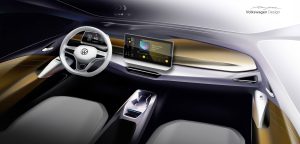

News
VW teases next generation ID.3 and needed upgrades
VW has teased the next generation VW ID.3 and its production plans for the vehicle.
In a press release this morning, Volkswagen showed off drawings of the upcoming second generation of the VW ID.3, some key upgrades coming to the vehicle, and production plans. But with all of these details on the trendy EV hatchback, the German automaker didn’t clarify if it would be coming to the U.S.
The images released by VW this morning are pretty striking. The new ID.3, while quite similar to the previous generation, seems to have adopted more aggressive styling cues seen on the Cupra Born version of the platform. Perhaps most striking in the renders is the heads-up display, but the smoothed-over front section is also a welcome design change.
- The new ID.3 comes in spring with a sharpened exterior design.
- The new ID.3 comes in spring with a sharpened exterior design.
- Design sketch: High-quality and partly sustainable materials will characterize the interior.
- Design sketch: High-quality and partly sustainable materials will characterize the interior.
- The new ID.3 comes in spring with a sharpened exterior design.
Other than the striking images, VW outlined a few upgrades coming to the ID.3. Foremost were improvements to software and interior tech; the ID.3 will finally be OTA update capable, have a larger 12-inch center screen, and improved software UI. On top of that, VW is promising improvements to tech performance and general software improvements. The press release did not address the performance capabilities of the new vehicle, leaving some to ponder if any technical enhancements will come with this new generation.
VW says that it will also be expanding production of the ID.3 from the Zwickau plant to the Wolfsberg plant and that pre-ordering is now available in Germany, with orders expected to be delivered starting in Q4 2023. The next generation ID.3 starts at 43,995 euros, including VAT ($46,135), and will be available in five trims; life, business, style, max, and tour. The full release of the vehicle is coming in the Spring of next year.
The new ID.3 is coming at a strange time for Volkswagen. While the company recently reached the milestone of half a million ID electric vehicles sold worldwide, they are also reconsidering building a new manufacturing facility that could aid in the company’s transition to electric vehicles. Simultaneously, the company is investing billions into its PowerCo battery manufacturing subsidiary, a company that they hope they can turn into a “global battery champion.”
When taken as a whole, many observers are unsure of the future of the VW Group. While VW certainly seems focused on EV introduction and production, it still has reservations and isn’t dedicating as much as many competitors. This is especially apparent in the United States, where VW has only introduced a single electric vehicle that hasn’t exactly become a raging success; the ID.4.
As VW progresses into its next generation of electric vehicles and begins introducing new hotly anticipated EV models, opinions on the company may change. However, VW has a lot of work to do to win over consumers who often see Volkswagen products as behind in technology and less affordable than competitors.
What do you think of the article? Do you have any comments, questions, or concerns? Shoot me an email at william@teslarati.com. You can also reach me on Twitter @WilliamWritin. If you have news tips, email us at tips@teslarati.com!

News
Tesla starts showing how FSD will change lives in Europe
Local officials tested the system on narrow country roads and were impressed by FSD’s smooth, human-like driving, with some calling the service a game-changer for everyday life in areas that are far from urban centers.

Tesla has launched Europe’s first public shuttle service using Full Self-Driving (Supervised) in the rural Eifelkreis Bitburg-Prüm region of Germany, demonstrating how the technology can restore independence and mobility for people who struggle with limited transport options.
Local officials tested the system on narrow country roads and were impressed by FSD’s smooth, human-like driving, with some calling the service a game-changer for everyday life in areas that are far from urban centers.
Officials see real impact on rural residents
Arzfeld Mayor Johannes Kuhl and District Administrator Andreas Kruppert personally tested the Tesla shuttle service. This allowed them to see just how well FSD navigated winding lanes and rural roads confidently. Kruppert said, “Autonomous driving sounds like science fiction to many, but we simply see here that it works totally well in rural regions too.” Kuhl, for his part, also noted that FSD “feels like a very experienced driver.”
The pilot complements the area’s “Citizen Bus” program, which provides on-demand rides for elderly residents who can no longer drive themselves. Tesla Europe shared a video of a demonstration of the service, highlighting how FSD gives people their freedom back, even in places where public transport is not as prevalent.
What the Ministry for Economic Affairs and Transport says
Rhineland-Palatinate’s Minister Daniela Schmitt supported the project, praising the collaboration that made this “first of its kind in Europe” possible. As per the ministry, the rural rollout for the service shows FSD’s potential beyond major cities, and it delivers tangible benefits like grocery runs, doctor visits, and social connections for isolated residents.
“Reliable and flexible mobility is especially vital in rural areas. With the launch of a shuttle service using self-driving vehicles (FSD supervised) by Tesla in the Eifelkreis Bitburg-Prüm, an innovative pilot project is now getting underway that complements local community bus services. It is the first project of its kind in Europe.
“The result is a real gain for rural mobility: greater accessibility, more flexibility and tangible benefits for everyday life. A strong signal for innovation, cooperation and future-oriented mobility beyond urban centers,” the ministry wrote in a LinkedIn post.
News
Tesla China quietly posts Robotaxi-related job listing
Tesla China is currently seeking a Low Voltage Electrical Engineer to work on circuit board design for the company’s autonomous vehicles.

Tesla has posted a new job listing in Shanghai explicitly tied to its Robotaxi program, fueling speculation that the company is preparing to launch its dedicated autonomous ride-hailing service in China.
As noted in the listing, Tesla China is currently seeking a Low Voltage Electrical Engineer to work on circuit board design for the company’s autonomous vehicles.
Robotaxi-specific role
The listing, which was shared on social media platform X by industry watcher @tslaming, suggested that Tesla China is looking to fill the role urgently. The job listing itself specifically mentions that the person hired for the role will be working on the Low Voltage Hardware team, which would design the circuit boards that would serve as the nervous system of the Robotaxi.
Key tasks for the role, as indicated in the job listing, include collaboration with PCB layout, firmware, mechanical, program management, and validation teams, among other responsibilities. The role is based in Shanghai.
China Robotaxi launch
China represents a massive potential market for robotaxis, with its dense urban centers and supportive policies in select cities. Tesla has limited permission to roll out FSD in the country, though despite this, its vehicles have been hailed as among the best in the market when it comes to autonomous features. So far, at least, it appears that China supports Tesla’s FSD and Robotaxi rollout.
This was hinted at in November, when Tesla brought the Cybercab to the 8th China International Import Expo (CIIE) in Shanghai, marking the first time that the autonomous two-seater was brought to the Asia-Pacific region. The vehicle, despite not having a release date in China, received a significant amount of interest among the event’s attendees.
Elon Musk
Elon Musk and Tesla AI Director share insights after empty driver seat Robotaxi rides
The executives’ unoccupied tests hint at the rapid progress of Tesla’s unsupervised Robotaxi efforts.

Tesla CEO Elon Musk and AI Director Ashok Elluswamy celebrated Christmas Eve by sharing personal experiences with Robotaxi vehicles that had no safety monitor or occupant in the driver’s seat. Musk described the system’s “perfect driving” around Austin, while Elluswamy posted video from the back seat, calling it “an amazing experience.”
The executives’ unoccupied tests hint at the rapid progress of Tesla’s unsupervised Robotaxi efforts.
Elon and Ashok’s firsthand Robotaxi insights
Prior to Musk and the Tesla AI Director’s posts, sightings of unmanned Teslas navigating public roads were widely shared on social media. One such vehicle was spotted in Austin, Texas, which Elon Musk acknowleged by stating that “Testing is underway with no occupants in the car.”
Based on his Christmas Eve post, Musk seemed to have tested an unmanned Tesla himself. “A Tesla with no safety monitor in the car and me sitting in the passenger seat took me all around Austin on Sunday with perfect driving,” Musk wrote in his post.
Elluswamy responded with a 2-minute video showing himself in the rear of an unmanned Tesla. The video featured the vehicle’s empty front seats, as well as its smooth handling through real-world traffic. He captioned his video with the words, “It’s an amazing experience!”
Towards Unsupervised operations
During an xAI Hackathon earlier this month, Elon Musk mentioned that Tesla owed be removing Safety Monitors from its Robotaxis in Austin in just three weeks. “Unsupervised is pretty much solved at this point. So there will be Tesla Robotaxis operating in Austin with no one in them. Not even anyone in the passenger seat in about three weeks,” he said. Musk echoed similar estimates at the 2025 Annual Shareholder Meeting and the Q3 2025 earnings call.
Considering the insights that were posted Musk and Elluswamy, it does appear that Tesla is working hard towards operating its Robotaxis with no safety monitors. This is quite impressive considering that the service was launched just earlier this year.













